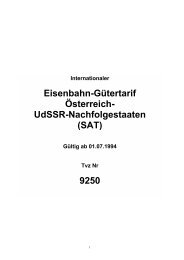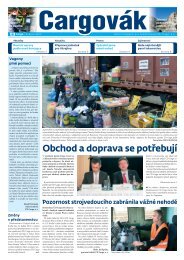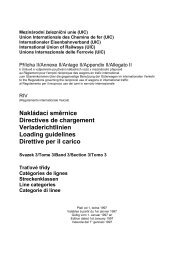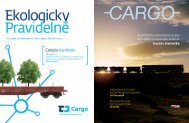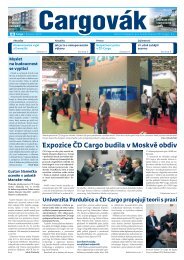Create successful ePaper yourself
Turn your PDF publications into a flip-book with our unique Google optimized e-Paper software.
ROZHOVOR / INTERVIEW<br />
je pro nás zejména silniční doprava. Na českém<br />
trhu si železnice drží podíl zhruba 22 %,<br />
zatímco na silnici připadají tři čtvrtiny<br />
všech přepravních výkonů v nákladní dopravě.<br />
Ve srovnání s vývojem v jiných evropských<br />
zemích, kde je podíl železnice i pod<br />
10 %, je to stále velmi dobrý výsledek, většina<br />
dopravních expertů je však přesvědčena,<br />
že podíl železnice na našem dopravním<br />
trhu ještě poklesne a bude se více blížit<br />
evropským průměrům. Tomu bychom rádi<br />
zabránili a naopak jsme přesvědčeni, že jej<br />
máme šanci i mírně zvýšit.<br />
Nyní převezeme za rok zhruba 90 milionů<br />
tun zboží, zatímco kamionová doprava kolem<br />
430 milionů tun. Kapacita železniční<br />
sítě je však nyní již omezená. Za stávajících<br />
podmínek infr<strong>as</strong>truktury můžeme růst jen<br />
přibližně ke 120 milionům tun. Po dobudování<br />
hlavních železničních koridorů a infr<strong>as</strong>truktury<br />
v ČR, což však potrvá ještě 5 až 6<br />
let, by se objem přepraveného zboží na železnici<br />
mohl dostat až na 140 či 150 milionů<br />
tun a na dopravním trhu by se podíl železnice<br />
mohl šplhat až ke 30 %.<br />
Došlo v České republice k harmonizaci<br />
podmínek mezi železničním a silničním<br />
sektorem formou zpoplatnění použití<br />
dopravní infr<strong>as</strong>truktury?<br />
Ano, na jednu stranu jsme sice samozřejmě<br />
uvítali spuštění výběru tzv. mýta na českých<br />
silnicích v loňském roce, ale na straně druhé<br />
jsme poněkud zklamáni z faktu, že metodika<br />
výběru poplatků stále není z našeho<br />
pohledu železničního dopravce ani zdaleka<br />
spravedlivá. Porovnáme-li sumy vybraných<br />
poplatků za uplynulý rok v jednotlivých sektorech<br />
nákladní dopravy (železniční 4,5 mi-<br />
liardy korun a silniční 5,5 miliardy korun)<br />
a vztáhneme-li tato čísla k výkonům v tunokilometrech<br />
(silniční doprava dosahuje cca<br />
čtyřnásobku výkonů železničních), zjistíme,<br />
že silniční dopravci tak hradí za použití infr<strong>as</strong>truktury<br />
jen přibližně 30 % toho, co dopravci<br />
železniční. Navíc se na železnici hradí<br />
poplatek za infr<strong>as</strong>trukturu na celé síti, na<br />
rozdíl od silničního sektoru. A to nemluvím<br />
o problematice tzv. externalit, tedy externích<br />
nákladů. Proto bychom uvítali alespoň<br />
postupné sbližování konstrukce obou systémů<br />
výběru těchto poplatků co nejdříve.<br />
Jakými nástroji chcete dosáhnout zvyšování<br />
podílu na dopravním trhu?<br />
Samozřejmě především rozvojovými programy.<br />
Hodláme se zaměřit na obnovu vozidlového<br />
parku, podporu výstavby logistických<br />
center napojených na železnici a zkvalitňování<br />
svých služeb zákazníkům. Jedině touto<br />
strategií dokážeme pokračovat v tempu růstu<br />
přeprav z posledních let, kdy naše výkony<br />
rostou o cca 4 % ročně. Plánujeme m<strong>as</strong>ivnější<br />
obnovu vozového parku, kde musíme strukturu<br />
nabídky řad vozů pružně přizpůsobovat<br />
poptávce zákazníků, to se nyní týká například<br />
kontejnerových vozů.<br />
V obl<strong>as</strong>ti budování logistických center<br />
máme v souč<strong>as</strong>né době několik záměrů. Nejvíce<br />
rozpracované je centrum v Lovosicích,<br />
kde již funguje základní terminál a vlaky<br />
již zajišťují spojení například s německými<br />
přístavy. Další aktuální lokality jsou v Brně<br />
a na Ostravsku, kde připravujeme projekt<br />
logistického řešení pro automobilku Hyundai<br />
v Nošovicích. Na rozdíl od kolínské automobilky<br />
TPCA by zdejší vnitřní vlečka měla<br />
být vybudována velkoryseji, aby bylo možné<br />
odvážet nejenom auta, ale také navážet vět-<br />
What about the process of lifting controls<br />
on the railway market in the Czech<br />
Republic? And how strong is the competition<br />
that <strong>ČD</strong> <strong>Cargo</strong> faces?<br />
The Czech Republic w<strong>as</strong> one of the fi rst<br />
countries that fully adopted the acquis communautaire<br />
in the fi eld of rail transport. As<br />
far back <strong>as</strong> 1995, conditions were created to<br />
liberalise our trade. Dozens of carriers are<br />
involved in rail freight transport on the territory<br />
of the Czech Republic. They established<br />
themselves on the market ten years<br />
ago, having taken over 10 percent of the<br />
volume of transported goods from Czech<br />
Railways, and the situation is stable. <strong>ČD</strong><br />
<strong>Cargo</strong> no longer enjoys a dominant position<br />
today. And it is clear that the market is controlled<br />
by road transport, while railways<br />
are the weaker player. Generally speaking,<br />
transport in the Czech Republic is a<br />
very market-oriented and quite competitive<br />
environment.<br />
As the European railway market becomes<br />
ever more liberalised, <strong>ČD</strong> <strong>Cargo</strong> intends to<br />
extend its services beyond the borders of the<br />
Czech Republic, in cooperation with other<br />
carriers or within trans-national alliances.<br />
There have been government-level debates<br />
about a possible merger of Czech and Slovak<br />
<strong>Cargo</strong>. In addition, <strong>ČD</strong> <strong>Cargo</strong> takes part<br />
in miscellaneous European Union projects.<br />
Within the EU, <strong>ČD</strong> <strong>Cargo</strong> holds fi fth place<br />
among major rail hauliers.<br />
What about the situation on the Czech<br />
transport market? How do you fare in<br />
competition with road haulage?<br />
Indeed, when we talk about competition we<br />
are talking mainly about road transport. On<br />
the Czech market, railways maintain their<br />
22 percent share in general, and road transport<br />
controls about three quarters of all<br />
freight haulage fi gures. This is still a good<br />
result in comparison with the trends in other<br />
European countries where the railway<br />
share may be less than 10 percent. But most<br />
transport experts believe that the share of<br />
rail on our transport market will continue to<br />
decline to the European average. We would<br />
like to change that and we actually believe<br />
we stand a chance of improving the situation<br />
slightly.<br />
Currently, we ship about 90 million tonnes<br />
of goods a year but trucks average 430<br />
million tonnes. The capacity of our railway<br />
network is pretty limited already. Given<br />
our present infr<strong>as</strong>tructure we can grow to<br />
achieve only some 120 million tonnes. When<br />
the main railway corridors and infr<strong>as</strong>tructure<br />
of the Czech Republic are completed –<br />
which will take fi ve or six years – the volume<br />
of goods transported by trains could<br />
šinu potřebných komponent pro jejich výrobu.<br />
Jinak se snažíme iniciovat i výstavbu<br />
vleček do závodů. Na jejich výstavbu existují<br />
různé, i vládní programy. Jejich fi nancování<br />
by totiž mělo být jakýmsi mixem. <strong>Ž</strong>elezniční<br />
infr<strong>as</strong>trukturu by měl zaplatit stát. Samotné<br />
skladovací plochy, budovy a přepravní mechanizace<br />
musí být hrazeny tím, kdo službu<br />
poskytuje. Tedy i naší fi rmou.<br />
Jaké jsou vaše vize rozvoje fi rmy? Kam<br />
chcete posunout <strong>ČD</strong> <strong>Cargo</strong> v následujících<br />
letech?<br />
Chceme se více soustředit na přepravu zboží,<br />
které vyžaduje větší podíl z hlediska organizace<br />
a logistiky, což je sice složitější, ale<br />
na druhou stranu také více tarifováno (zpoplatněno).<br />
Tyto přepravy byly a dodnes jsou<br />
spíše doménou silniční dopravy. Chceme<br />
přepravovat nejen tradiční komodity železniční<br />
dopravy jako hromadné substráty, stavebniny,<br />
dřevo, ale také komponenty pro<br />
automobilový průmysl (automotive), paletované<br />
zboží a samozřejmě zvýšit objem kontejnerových<br />
přeprav.<br />
Dalším nezbytným krokem je rozšíření<br />
spektra služeb pro zákazníky. Mám na mysli<br />
zabezpečování navazujících služeb. Logistické<br />
terminály by měly do budoucna sloužit<br />
i jako distribuční sklady, které se dnes č<strong>as</strong>to<br />
vysunují z výrobních závodů. Firmy, které se<br />
zabývají logistikou, pak zajišťují distribuci<br />
z těchto skladů pro vícero fi rem. A to je naším<br />
cílem − začít se více uplatňovat na tomto<br />
trhu. Trh v České republice v tomto oboru<br />
roste, na prvním místě drží velký podíl tzv.<br />
automotive, tj. návoz komponentů do továren<br />
i expedice hotových produktů – automobilů<br />
k zákazníkům.<br />
Dále se nyní více zaměřujeme na přepravy<br />
„Just in time“. Dříve si „timing logistiky“<br />
– tj. skladování a distribuci, vykonávaly fi rmy<br />
samy ve svých závodech, dnes je trend vysunout<br />
tyto činnosti mimo závod a přenášet je<br />
na logistické fi rmy, které zajišťují distribuci<br />
ze svých skladů pro více zákazníků. Podporou<br />
budování logistických terminálů a napojování<br />
distribučních skladů na železnici, ale<br />
i spoluprací se silničními dopravci chceme<br />
získat další podíl zákazníků a stávajícím zákazníkům<br />
nabídnout přidanou hodnotu.<br />
Obecně je naší strategií orientace na zákazníka,<br />
spolehlivost, rozvoj logistiky a navazujících<br />
služeb, větší spolupráce s partnery −<br />
s národními i ostatními dopravci, silničními<br />
i logistickými. Právě logistické fi rmy vytvářejí<br />
logistické řetězce a toho se musíme aktivně<br />
úč<strong>as</strong>tnit. <strong>ČD</strong> <strong>Cargo</strong> za tímto účelem drží<br />
podíly v některých logistických společnostech,<br />
např. BohemiaKombi nebo <strong>ČD</strong> Logistics.<br />
Jsme si vědomi, že pokud chceme uspět, cesta<br />
vede právě touto formou spolupráce. ●<br />
incre<strong>as</strong>e to 140–150 million tonnes and the<br />
railway’s share of the transport market<br />
could climb to 30 percent.<br />
H<strong>as</strong> the Czech Republic harmonised rail<br />
and road shipment conditions by imposing<br />
fees for the use of the transport<br />
infr<strong>as</strong>tructure?<br />
On the one hand we of course welcomed the<br />
imposition of the road toll in 2007 but we<br />
have been a bit disappointed <strong>as</strong> the method<br />
of toll collection does not seem to be completely<br />
fair from the viewpoint of a railway<br />
shipper. If we compare the toll sums collected<br />
in the p<strong>as</strong>t year in the various freight<br />
shipment sectors (CZK 4.5 billion on the rail<br />
and CZK 5.5 billion on the road) to the performance<br />
fi gures me<strong>as</strong>ured in tonne-kilometres<br />
(road transport achieves about four<br />
times the fi gures for railway shipments), we<br />
see that truckers pay only about 30 percent<br />
of the amount paid by railroads for the use<br />
of infr<strong>as</strong>tructure.<br />
Moreover, railways pay for the infr<strong>as</strong>tructure<br />
of the entire network, in contr<strong>as</strong>t<br />
to the road. I haven’t even touched on the<br />
issue of external costs. We would therefore<br />
welcome at le<strong>as</strong>t a gradual harmonisation<br />
of the ways these fee-collection systems are<br />
set up.<br />
How are you planning to incre<strong>as</strong>e your<br />
share of the transport market?<br />
We of course want to primarily use development<br />
programmes. We are going to centre<br />
on the renewal of our rolling stock, on supporting<br />
the development of industrial parks<br />
connected to railways, and on improving<br />
services for customers. This is the only<br />
strategy that will help us maintain the shipping<br />
volumes achieved in p<strong>as</strong>t years when<br />
our performance figures were growing<br />
by about four percent a year. We are planning<br />
a m<strong>as</strong>sive upgrade of our rolling stock<br />
where we must fl exibly adapt the structure<br />
of carriages to our customers’ requirements;<br />
this refers, for example, to our container<br />
carriages.<br />
We have some plans in developing logistical<br />
centres. Chief among them is the Lovosice<br />
centre with a b<strong>as</strong>ic terminal from which<br />
trains run to German seaports, for example.<br />
Other planned localities are in Brno and<br />
the Ostrava area, where we are preparing a<br />
logistical solution for the Hyundai <strong>as</strong>sembly<br />
plant in Nošovice. Unlike the Kolín-b<strong>as</strong>ed<br />
TPCA automobile plant, the Nošovice siding<br />
should be able to ship out cars and receive<br />
most of the component parts needed. We<br />
also want to help build factory sidings<br />
under various programmes, including those<br />
envisaged by the government. The funding<br />
INTERVIEW / ROZHOVOR<br />
should be mixed; the government should<br />
pay for the railway infr<strong>as</strong>tructure while the<br />
warehouses, buildings and transport technologies<br />
should be paid for by the service<br />
providers, and that includes us.<br />
What is your vision of the company’s<br />
future development? Where do you see<br />
<strong>ČD</strong> <strong>Cargo</strong> in the next few years?<br />
We want to narrow our focus to the shipments<br />
that need more organisation and<br />
logistical support, which is more complicated<br />
but also better compensated. These<br />
shipments have historically been in the<br />
realm of road transport. We want to ship<br />
not only traditional train loads such <strong>as</strong><br />
bulk substrates and building materials but<br />
also automotive industry parts and palette<br />
goods, and we of course want to incre<strong>as</strong>e<br />
the volume of container transport.<br />
Our crucial next step is to expand the<br />
spectrum of services we offer to our customers.<br />
I am talking about follow-up services.<br />
In the future, logistical terminals should be<br />
the warehouses that are often being shifted<br />
from manufacturing plants today. Logistics<br />
agencies will then distribute goods from<br />
the warehouses to several customers. And<br />
this is our goal – to incre<strong>as</strong>e our share of<br />
this market. This market is growing in the<br />
Czech Republic, led by the automotive component,<br />
which supplies new parts to factories<br />
and ships fi nished products – cars – to<br />
customers.<br />
We are also now focusing more on “justin-time”<br />
shipments. Logistical timing, that<br />
is, warehousing and distribution, used to be<br />
conducted by the manufacturer in his plant,<br />
but the current trend is for manufacturers<br />
to eliminate this chore and delegate it to<br />
the logistics fi rms that distribute products<br />
from warehouses to multiple customers.<br />
By supporting the construction of logistics<br />
terminals, by connecting them to railways,<br />
and also through cooperation with road<br />
hauliers, we want to win over more customers<br />
and to offer added value to our present<br />
clients.<br />
Generally speaking, our strategy is oriented<br />
towards the customer, offering reliability,<br />
better logistical and follow-up services,<br />
and broader cooperation with our<br />
partners – national and other operators<br />
in the are<strong>as</strong> of road haulage and logisitcs.<br />
Logistics companies create logistical chains<br />
and we want to take part in them. For this<br />
purpose, <strong>ČD</strong> <strong>Cargo</strong> holds shares in certain<br />
logistics companies, such <strong>as</strong> BohemiaKombi<br />
and <strong>ČD</strong> Logistics. We know that if we want<br />
to succeed it will be through this form of<br />
cooperation. ●<br />
26 REVUE PRO DOPRAVU A LOGISTIKU REVUE FOR TRANSPORT AND LOGISTICS 27



